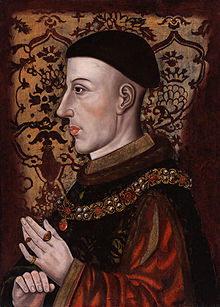Le Roy Engloys

Le Roi Anglois[a] (English: The English King) is a song found in the Bayeux Manuscript,[1] a collection of more than a hundred songs compiled at the start of the 16th century AD by Charles III de Bourbon and written at the end of the 15th century AD, some dozens of years after the end of the Hundred Years' War.
The song contains numerous historical errors due to the fact that its composition took place close to half a century after the events it recounts. The English King Henry V is said to have died in Saint-Fiacre in Brie,[1] while in reality he died in Vincennes. "Captain Prégent" is Prigent VII de Coëtivy, one of the victors, along with Jean de Clermont, of the Battle of Formigny,[2] on 18 April 1450 (3,500 dead on the English side, 500 on the French side). The Middle French word used for "tails" (couez), bears a resemblance to the word "couard", meaning "coward".[3] The word "Godon" was a French ethnic slur for English people,[4] which may be the result of a corruption of "God-damn".[5]
Lyrics
[edit]| Middle French lyrics | Standardized Middle French lyrics[b] | English translation |
|---|---|---|
Le Roy engloys ſe faiſoit appeller |
Le Roi Anglois se faisoit appeller |
The English King named himself |
Notes
[edit]- ^ Attested in the Bayeux manuscript as Le Roy engloys.
- ^ Middle French was not a standardized language. The lyrics attested in the Bayeux Manuscript are presented with a retroactive scholarly standardization for the sake of legibility.[6]
References
[edit]- ^ a b Gérold, Théodore (1921). Le Manuscrit de Bayeux, texte et musique d'un recueil de chansons du XVe siècle. Librairie Istria: Faculty of French Literature and Language of the University of Strasburg. p. 103. read online
- ^ Nicolle, David (2012). The Fall of English France 1449–53. p. 29.
- ^ EFFE, Frédéric (22 April 2016). "Le Roy Engloys ou le roé anglais". moyenagepassion. Retrieved 16 July 2020.
- ^ de Ullmann, Stephen (December 1947). "Anglicisms in French-Notes on Their Chronology, Range, and Reception". PMLA. 62 (4). Modern Language Association: 1155–1156. doi:10.2307/459155. JSTOR 459155.
- ^ Foulsham, Martha; Gunther, G.; Ryan, John S. (1992). "Appendix 1 Godams (Thesis, part 5)". Stand Up the Real Maid: The St Joan Theme in Selected Modern English Language and European Authors (Thesis). p. 231.
- ^ "Chansonnier , dit Manuscrit de Bayeux", Gallica (digital library), FR: BnF, p. 89
